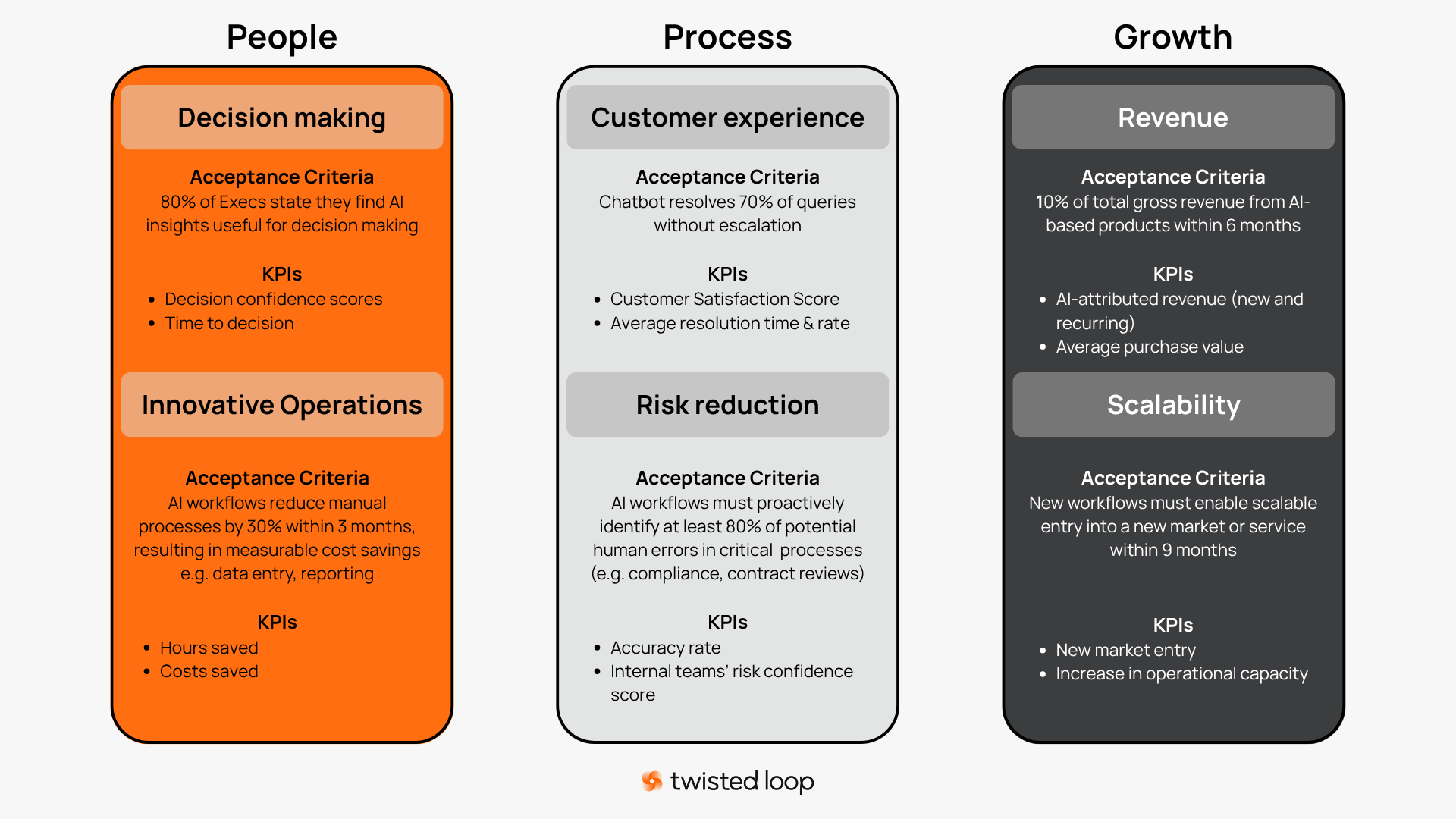How to measure the impact of your AI initiatives
From predictive forecasting to hyper-responsive customer service, the appetite for AI investment has surged across the SME landscape.
But as enthusiasm spreads and budgets grow, so does scrutiny. Business leaders, boards, and investors aren’t just asking “What can it do?” — they’re now demanding “What did it deliver?”
This shift brings a critical challenge to the fore: how do we actually measure the impact of AI?
Why measurement really matters
In our clients' boardrooms, there's a growing mindset: if something can't be measured, it can't be justified - and securing additional budget for it becomes nearly impossible.
This is why we advise our clients to take AI impact measurement seriously and catalyse change in your business from the top down.
By outlining your goals at the beginning of an AI initiative, you can:
Secure additional buy-in across the business, especially from risk-conscious stakeholders
Ensure AI aligns with commercial priorities and your overall business strategy
Give more confidence to the board, and secure future spending
Set the foundation for scale, proving early wins and informing future strategy
What makes measuring AI initiatives so difficult?
Unlike traditional systems, AI doesn’t always follow a straight line from investment to return. Its impact is often:
Delayed — benefits might show up months after deployment
Cross-functional — outcomes touch multiple departments
Qualitative — improvements in speed, trust, or decision-making are harder to quantify
Non-linear — a small tweak can unlock big gains, or vice versa
And while cost savings are easy to spot, other value types — like risk reduction, better data hygiene, or faster insight generation — often fly under the radar.
Our practical framework for measuring AI impact
So how do you move from ambiguity to clarity?
Start by aligning each AI initiative with a business objective. Whether it’s revenue growth, operational efficiency, or customer retention, knowing why you’re doing it is the foundation for knowing how to measure it. From there:
Define your success metrics early. Use the framework below to spark some ideas
Baseline your performance before starting work on your AI initiatives. Without this, there’s no benchmark
Use proxy metrics if needed. For example, lead response time as a proxy for conversion improvement
Blend anecdotal and empirical data. Combine dashboards with stakeholder feedback to capture the full picture
Make it ongoing. Review your metrics regularly as both the AI and your business evolve
Leaders and investors: what to do next
Whether you’re a CEO of a scaling business or sitting on the board as an investor, here’s how to put this into practice:
Nominate an AI value lead: Someone who owns the business case and ensures alignment
Pick a high-impact, low-complexity use case: Avoid trying to measure everything all at once
Build a simple dashboard: Focus on 3–5 KPIs that truly reflect business impact
Ask the ‘so what?’ question: “If we hadn’t deployed this, what would be the cost or missed opportunity?”
Get finance involved early: Ground assumptions in commercial logic from the outset
For investors: Request AI impact reporting in board packs and operational reviews
What we’re seeing on twisted loop client projects
One client had already made bold moves on their AI strategy when we were brought in to deliver a suite of high-impact solutions designed to strengthen their market position and support international expansion.
The delivery was a success, but the real challenge emerged post-implementation.
When their board asked, “How is this improving the business?” it became clear that, because objectives and baselines hadn’t been defined at the outset of their strategy, the internal team faced pressure to backfill value narratives - never an easy task, even with excellent solutions in place.
In contrast, where we’ve seen clients set clear KPIs early and review them collaboratively throughout, there’s been a smoother path to demonstrating ROI and unlocking further investment in AI.
Rethinking ROI in an AI world
AI is not just about cost savings or clever automation. It’s a strategic lever for scaling operations, unlocking insights, and gaining a competitive edge. But to secure long-term buy-in, leaders must speak the language of value.
That means building an ROI mindset into every stage of AI adoption — from planning to pilot to post-launch.
How twisted loop can help your business
We’re a consultancy that helps ambitious businesses unlock new value, by turning vision into capability and capability into growth.
We work at the intersection of strategic definition & execution and Data & AI delivery, helping our clients to:
Scale operations with intelligence and precision
Embed the data & AI capabilities required for future growth
Unlock new sources of enterprise value
Build internal confidence to lead the next phase of growth
Whether you’re scaling a business or evolving a portfolio (whether you're seeking greater efficiency, looking to scale, or want to head in a new direction), we help you progress with clarity, confidence and capability.


